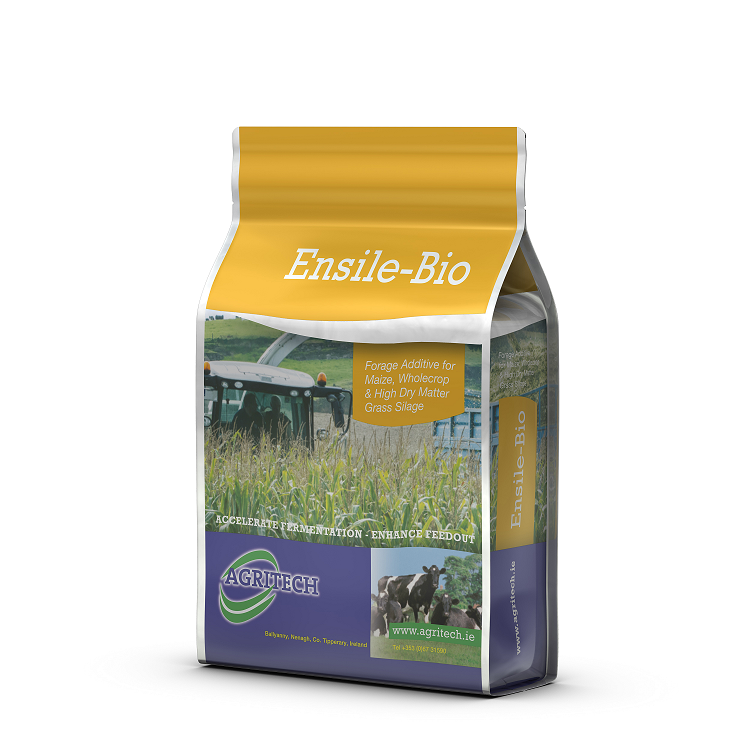
Maize silage offers both dairy and beef farmers an opportunity to increase animal performance from home grown forage. Milking cows that are fed maize silage as part of their total forage intake, have milk yield increases of 8%-10% and cattle have shown additional improvements in daily live weight gains. It is one of the most complementary feeds to grass silage as it is high in starch and fibre and is slowly digested in the rumen.
However, to really see these benefits there are a few key steps in managing the crop at harvest that should be followed. Agritech’s Bil Ryan outlines a few tips that will have a positive impact on how your crop of maize performs at feed out.
Harvest Targets
The aim is to harvest your maize crop as close to 30% dry matter and 30% starch content as possible as this gives the best results both in terms of yield and subsequent animal performance. A rough rule of thumb is to have the plant two thirds brown and the cobs fully formed with no soft grains. Once at this stage of maturity it is ready to harvest.
When it comes to harvesting and ensiling the crop, it is best practice not to chop the crop too finely, but to use a corn cracker on the machine to ensure the grain is split open. This is to ensure that at feed out, the animal’s digestive system can fully and easily access the starch.
Pit Preparation
Due to Ireland’s unpredictable weather it can be difficult to get perfect harvest conditions thus providing an obstacle to getting good pit preservation. A helpful tip is to have the silage pit prepared well in advance of expected harvest date; washed out and protective polythene sheets laid down inside the pit walls to facilitate an excellent seal at the pit edges. The risk of soil contamination should also be minimised by having an adequate concrete apron to work off and keep machinery tyres as soil free as possible.
The pit should be filled in thin layers from front to back and each layer well consolidated to remove all air. A poorly compacted pit will run a high risk of secondary heating once opened for feeding.
I will readily admit that to achieve all these elements is not easy at farm level. That is why most Irish farmers use an additive such as Agritech’s Ensile Bio. Ensile Bio is specifically manufactured to suit typical Irish conditions. It is designed to preserve the crop in the shortest time possible and does so by producing acids which minimise the growth of yeast and moulds that naturally grow on high dry matter starch crops. By producing these acids rapidly it ensures a stable pit face at feed out for up to 10 days. Pit face stability is extremely important as the energy lost at the pit face could not only reduce animal feed intake but also lead to losses of valuable energy from the clamp.
The final step is to use a vacuum sheet as the first sheet and cover by folding in the two side sheets and fitting the final top sheet. Weigh down with tyres to secure the clamp.
For any further advice on harvesting maize, contact your local Agritech distributor or find out more about Agritech’s Maize additive Ensile Bio by clicking here.



Very nice article and straight to the point.
I am not sure if this is really the best place to
ask but do you people have any ideea where to hire some professional writers?
Thx 🙂 Escape room lista
Very interesting topic, thanks for putting up.!
mexican rx online
https://cmqpharma.com/# mexican mail order pharmacies
mexican rx online
purple pharmacy mexico price list: cmq pharma – п»їbest mexican online pharmacies
https://indiapharmast.com/# online shopping pharmacy india
pharmacies in mexico that ship to usa mexico drug stores pharmacies purple pharmacy mexico price list
best india pharmacy: mail order pharmacy india – mail order pharmacy india
medication from mexico pharmacy: mexican mail order pharmacies – mexican rx online
https://indiapharmast.com/# best online pharmacy india
What’s up, every time i used to check website posts here in the early hours in thedawn, since i love to find out more and more
buy medicines online in india: top 10 pharmacies in india – online pharmacy india
canadian world pharmacy: best mail order pharmacy canada – adderall canadian pharmacy
mexican online pharmacies prescription drugs medicine in mexico pharmacies mexican drugstore online
http://canadapharmast.com/# best canadian pharmacy online
pharmacy website india: buy prescription drugs from india – india pharmacy mail order
mail order pharmacy india: buy prescription drugs from india – cheapest online pharmacy india
world pharmacy india: mail order pharmacy india – top 10 pharmacies in india
best online pharmacies in mexico medicine in mexico pharmacies п»їbest mexican online pharmacies
india pharmacy: п»їlegitimate online pharmacies india – Online medicine home delivery
buy medicines online in india: Online medicine home delivery – indian pharmacy online
п»їpaxlovid: buy paxlovid online – paxlovid pill
http://amoxildelivery.pro/# amoxicillin without rx
amoxicillin cephalexin: amoxicillin 30 capsules price – amoxicillin tablets in india
https://paxloviddelivery.pro/# paxlovid price
http://doxycyclinedelivery.pro/# doxycycline hyclate
buy cipro online usa: ciprofloxacin – buy cipro without rx
https://clomiddelivery.pro/# how to buy clomid online
http://paxloviddelivery.pro/# paxlovid buy
paxlovid covid: paxlovid pharmacy – paxlovid india
http://clomiddelivery.pro/# can i get clomid pills
buy doxycycline tablets 100mg: where can i order doxycycline – doxycycline uk cost
http://doxycyclinedelivery.pro/# doxycycline 100 mg forsale outside the us
http://doxycyclinedelivery.pro/# doxycycline 100 mg tablets
cost cheap clomid without prescription: where to get generic clomid online – cheap clomid without insurance
https://amoxildelivery.pro/# can you buy amoxicillin over the counter
ciprofloxacin mail online: cipro – cipro ciprofloxacin
price doxycycline: buy doxycycline united states – 40mg doxycycline